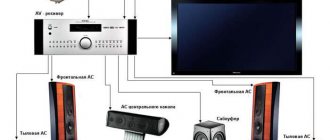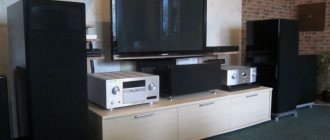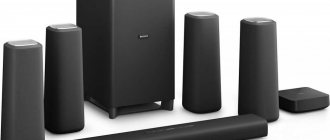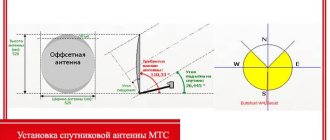Distance and pressure
So, according to the standards, we should get a sound pressure of 85 dB (105 at peak) without distortion across the entire frequency band. Sound pressure at a distance of 1 meter from the speaker when 1 Watt of power is applied to the speaker is “sensitivity”; it is almost always indicated in the product data sheet. Next, we calculate the maximum sound pressure at the listening point - each doubling of power will give us +3 dB of sound pressure, and each doubling of the distance will give us a decrease of -6 dB.
Recording the soundtrack for the animated film “How to Train Your Dragon 2” at Abbey Road Studios in London
Let's take, for example, the most common acoustics for music with a typical sensitivity of 91 dB. At a distance of 4 meters, due to a roll-off of –12 dB, it is necessary to compensate for the losses with an additional gain of 105–(91–12) = 26 dB. This is roughly equivalent to a 500W amplifier. Not all speakers are ready to withstand such power.
However, that's not all, the main problem is that in speaker specifications, power parameters are indicated based on a signal with a frequency of 1000 Hz and, much less often, in pink noise. Therefore, when choosing speakers, it is better to have a maximum pressure margin of 3–6 dB.
There are a couple of ways to increase sound pressure. You can place the speaker in the plane of the wall, then we will get an additional 5–6 dB at frequencies below ~300 Hz. Or use active multiamping, when passive crossover filters are excluded from the system and active electronic (usually digital) crossovers for power amplifiers are used instead. In this case, bandpass amplifiers are connected directly each to their own speaker, which helps to obtain greater sound pressure and better quality.
Selecting a home theater: choosing a signal source
Next, you should go directly to the signal source. Decide what will act in this capacity.
Connoisseurs of new video products, accordingly, will put forward their demands for cable or terrestrial TV, DVD and Blu-ray players, or just a media player, which is more reasonable given the rapid obsolescence of video formats. Fans of streaming music or online games have their own requirements. In addition to the signal source itself - high-speed Internet due to the appropriate characteristics of the router - the latter may need a UPnP server.
What acoustics for cinema should I buy?
Unlike musical acoustics, where listeners may like some coloration of the sound, this approach is unacceptable in cinema systems. Cinema requires minimal distortion from speakers, no aftertaste and high sound pressure. Therefore, in a recreation center you should not use tube amplification and audiophile acoustics with a “special” sound. In a cinema, it is necessary to ensure a minimum number of room reflections, so speakers with a narrow diagram and those where the directivity properties depend little on frequency are best suited for it. As many people know, horn-type speakers have similar characteristics, and with a so-called horn. "constant focus".
Recording of the soundtrack for the film "Star Wars: The Force Awakens" at MGM Studios, California
I can say that the most successful is an elliptical horn with a directivity of 60x90 degrees. Next, you can consider ordinary speakers with dome and conical diffusers, but it is better to avoid different types of “panel” acoustics (electrostats, tape, AMT and others), even if they are used only in the high-frequency section - they have very uneven directivity and problems with overload ability at low frequencies. Dipoles and omnidirectional types of speakers are not suitable for cinemas, with the exception of special wall-mounted models (the so-called “surrounds”).
Of the design types, I will put a low-efficiency bass reflex (port area less than ~15% of the woofer diffuser area) in first place, and a closed box in second place. Types such as “labyrinths”, TDL, reverse horns, etc., where the rear radiation is almost completely output outside with a delay, are not suitable for DC, as are open design options.
Comfort issues
We have outlined the algorithm for how to assemble a home theater. But to obtain maximum emotions and the full effect of involvement, a comfortable viewing environment is necessary. It is based on two factors – control comfort and comfortable body position for the viewer.
The first factor is achieved by using a minimum number of control panels. A home theater complex includes a lot of devices. And it is advisable to control them from one programmable remote control or from a familiar smartphone, which is always at hand, using the appropriate application.
The desired relaxation and comfortable viewing are provided by specialized designer furniture. Sofas and armchairs (certain models with a wide range of custom settings or accessories) will help you spend many hours watching content without unpleasant physiological sensations. And brackets, branded stands, shelves and cabinets will ensure the optimal position of acoustics and other home cinema components in relation to viewers and listeners. At the same time, they will ensure harmonious integration of the equipment into the interior and high ergonomics of its operation.
Placing acoustics in the room
Naturally, in film sound there are standards for the placement of speakers - in particular, the angle relative to the listener’s position is indicated, and, if possible, these standards must be adhered to in order to get the sound “as the director intended.”
The picture above shows a diagram of the arrangement of speakers in one of the most common 7.1 formats: three front channels, two side, two rear and a subwoofer (its location is not standardized, since it is believed that human hearing is not able to determine the position of the source at such a low sound frequency). If you build a DC in the most common frame format of 2.40:1 with a recommended viewing angle of 35-55 degrees, then, as can be seen in the image, the front channels can be either in the screen format, or the central channel behind the screen, and the side channels at the edges of the canvas. And this will be the best option. First of all, because the side channels should be moved apart to the maximum value in the standard ±30 degrees. Then you will get a uniform panorama between the front and side speakers, and the central channel will be in front of the screen, which will avoid losses in the sound-transparent fabric (high frequencies are absorbed by 1-6 dB for a fabric version, and up to 12 dB for a perforated one).
Let me make a note about the location of the central channel. Placing it under the screen on the floor, as you often see, is a very bad mistake. This way we will get a strong re-reflection of sound from the floor, which will reduce the intelligibility of dialogues and give an easily determined direction to the sound source, which absolutely does not coincide with what is happening on the screen. For this reason, the “legal” position of the center channel is that the emitter should be at a height of 5/8 from the bottom of the screen. The front LR channels and surround (for 5.1 and 7.1 formats) are located at the same height.
Recording of the soundtrack for the film "Life of Pi" at The Newman Scoring Stage, Los Angeles
I would like to note that new 3D audio formats, like Dolby Atmos, DTS:X, Aura 3D - they all have different maps of the standard speaker layout. And then what to do if you are building the “best” recreation center? A solution can be offered by sound processors, such as the Trinnov Altitude 32 with its 3D Remapping function, which virtually “rearranges” the speakers into their places in full accordance with the reproduced standard. Today, this is the only device that promises such virtual “permutations” on one set of speakers.
Ladies test for manually setting up a TV panel
Before you start, you need to download images in the appropriate resolution. Kits available for:
- 4K screens;
- Full HD displays.
Next, automatic filters are turned off if they are enabled. The media is connected to a TV or cinema. Manual adjustments are made for each of the 5 parameters. They are lower.
Borders and image format
The criterion for evaluating this parameter is very simple: the arrows along the edges of the picture must be completely visible.
The tops of these arrows are aligned with the edges of the pictures, so you will immediately see if the screen is cutting off the image on one side.
Borders and image format
The second point is the aspect ratio.
It is difficult to determine from faces and irregularly shaped objects whether a picture is stretching or shrinking. But with the help of tuning grids, everything is visible at once.
Aspect Ratio
The scan parameter is adjusted, frequent names in the menu:
- Overscan;
- Pixel-to-Pixel;
- Just Scan
- Original,
- Full Pixel.
Brightness level
At the bottom there are stripes with rectangles, inside each of which there are squares that differ in tone. At the top there are two stripes, which represent 32 tones of gray. Normally, the boundaries of each of them should be clearly distinguishable.
Accordingly, if you do not see squares on the black rectangles below or in any of the areas above, the rectangles merge, which means you need to increase the brightness.
If a similar situation occurs with white color, then the brightness needs to be reduced.
Brightness level is low
Brightness level high
Contrast level
The assessment of the norm for the contrast indicator must be carried out using the same scales with gray gradations on the stripes at the top and bottom.
This is what a low contrast level will look like - the squares do not merge, but the image is clearly deteriorating.
Contrast level is low
And this will happen at a high level of contrast.
High contrast level
Color correction
The entire color palette is presented at the bottom. With the correct balance, squares that are slightly different in tone should be visible against the background of colored rectangles.
If the balance is incorrect, they will not be visible.
Color balance
Image clarity
The last step is to make sure that the intersecting lines in these areas are clearly visible, without halo or any shadow.
Image clarity
If there is a shadow, you need to change the level of clarity. An additional marker for this case will be the faces of the girls.
Acoustic placement errors
So, I will touch on the main mistakes when placing speakers and possible methods for correcting them.
1. It is not possible to use a sound-transparent screen. In such cases, you can place the center channel speaker above the screen. Another option is to enable the virtual center channel feature that some projectors have. This might work even better than putting it on top of the canvas.
2. Placement of side channels too close to the viewer (elongated room). In this case, when several spectators sit in the same row, it will become impossible to ensure a balance of sound from the side channels for all spectators except the central one. The only way to solve this problem is to raise the side channels higher, thus averaging the distance to the viewers.
Recording of the soundtrack for the film “Mission: Impossible: Ghost Protocol” at The Newman Scoring Stage, Los Angeles
3. Spectator seats are placed close to the wall. In general, it is better to avoid such an arrangement of seats right away; it is fundamentally wrong. But if there is no other option, the only way to improve something is to use a dipole type of speaker on the rear wall above the audience.
4. The use of inexpensive low-power ceiling speakers. Often they are placed a little away from the viewer, and if you add the height of the ceiling, then the final distance from the speakers to the viewer will exceed the same threshold 4 meters that I wrote about at the beginning of the article. The processor can partially correct this situation, but it cannot be completely “cure”; this is a compromise solution.
5. All speakers must be directed to the center of the spectator area, or rather to the VIP seat. This rule is often neglected and speakers are placed parallel to the walls of the room. The result is increased unevenness and strong reflections from the walls of the room.
6. Excessive expansion of the viewing area. Remember, accurate channel-by-channel delays can only be made for one point (seat) in the hall, so the audience needs to be “seated” as compactly as possible.
7. I also consider placing the speakers in 5.1 format, when it is possible to install 7.1, a mistake. In 5.1 format, there is always a noticeable gap in the front-side panorama, and the use of two additional speakers and a pair of amplification channels does not significantly increase the cost of the estimate.
8. Using one subwoofer. With one low-frequency driver in the system, it is almost impossible to obtain uniform sound pressure throughout the entire viewing area. For illustration, below is a graph for measuring one system in a room of 60 sq.m. in an area of approximately 3x2 meters. Please note that low frequency flatness can reach up to 30 dB depending on the measurement location.
Two rows, a pair of seats in the first row and three seats in the second are marked in the center of the 50 sq.m. hall. in a position approximately 3/4 along the length of the hall. It is clearly visible that the unevenness at some frequencies reaches more than 30 dB
For these reasons, high-end home theaters have more than one subwoofer. The optimal number is 4, and the minimum is 2. In this case, a pair of subwoofers are placed in the centers of opposite walls, and if you take four low-frequency drivers, then there will be more ways (Harman research).
With this placement of subs, uniform low-frequency coverage of the entire viewing area is achieved, but it is necessary to use parametric equalizers to level out several peaks of sound pressure. First, for each of the subs, a delay is set in the settings, which compensates for the difference in the distances of the low-frequency speakers to the center of the viewing area, and then its response is equalized using an equalizer, and then a filter is also applied in the common LF channel. This is a very difficult task, but there is no simpler way. Multichannel audio processors are designed to make it somewhat easier, but remember that you need to choose a model with a sufficient number of channels, because each subwoofer will take one for itself. Although you can reduce the number of channels with a slight loss of quality if you output one channel to a pair of subwoofers.
TV or projector?
This choice is the second step for a potential buyer of a home theater complex. As a rule, it is carried out based on the project budget, ambitions and requirements of the potential buyer.
If you want to get a full-scale “home cinema” with complete immersion in what is happening and do not intend to save every penny on your desire, then you should prefer projectors. Their selection and price range is very wide. But all of them make it possible to provide a screen with a diagonal that, at a similar cost, is unattainable for televisions. On the other hand, for a projection system you will need to organize high-quality dimming and select a “projector-screen” duo based on operating conditions. Accordingly, choose thick curtains that will tightly cover the window when closed manually or automatically.
If the distance to the wall is quite small or the budget is limited by not very large numbers, it is worth making a choice in favor of one or another TV model. In addition to the diagonal and resolution (now 4K and HDR are becoming more accessible every year), it is worth paying special attention to the technology that is implemented in a particular candidate for purchase. In particular, choose between LED and OLED technologies. The first is more universal and accessible. The second provides higher contrast, which affects the quality of perception of video content.
Gain and cables
For home theater, high-power Class AB "current" amplification is always preferable. However, for large projects it is better to take switching amplifiers, since they have significantly less heat dissipation in idle mode - about 5-8%, which is less than a kilowatt in a DC circuit with a total power consumption of 5-10 kW. In turn, analog amplification in idle mode will consume about 3 kW. In addition, good analog amplifiers with a power of more than 300 W per channel are very expensive, and there are very few on the market capable of delivering 500 - 1000 W - there is nothing to choose from. While the sound quality of modern pulse amplifiers is no longer inferior to the best examples of analog amplification.
Recording of the soundtrack for the film "Die Hard 5: A Good Day to Die" at The Newman Scoring Stage, Los Angeles
In addition to the ordinary problems of speaker cables with insufficient cross-section and current limitation, there is one more that home theater builders should be reminded of - the skin effect. This "effect" causes a delay in the low-frequency component of the signal and is well known in stereo systems. There, flat cables, coaxial structures, a set of thin insulated conductors (Litz wire), etc. are used to combat. But in the case of cinema, this problem is easier to solve. As a rule, DC uses a frequency division of 80 Hz (subwoofers operate below), so the consequences of the skin effect are easily corrected by delays in the main channels relative to the low-frequency effects channel.
Part 1: Building a home theater: acoustic treatment of the room (part 1)
Looking for the best receiver
A home theater setup wouldn't be complete without a good AV receiver. Its processing of audio signals from a digital source ensures their conversion into multi-channel audio. Frequency correction and delay time adjustment, which provides spatial effects when broadcasting sound to different speakers, is also provided by this unit.
Accordingly, the selected model of such equipment must have at least 7 outputs for connecting acoustics (fewer at the moment no longer makes sense). In addition, it must support the maximum possible number of current sound formats, have sufficient output power per channel and support 4K.
Connecting the speaker system
Now you need to connect the speaker system. For good sound you need five speakers. The location of the center and front pair must correspond to a line outlining a virtual circle, whose radius is equal to the distance “listener - central AC”; the main and front AC are installed at the same distance from the listener.” The subwoofer is tuned in a special way, at this point everything depends on the skills and preferences of the tuner.
The lineup
Let's look at popular Samsung home theater models.
HT-J5530K
One of the most popular models from Samsung, which allows you to work with almost all devices and accepts most of the media existing today. Interfaces include Bluetooth. The power of the speakers is 165 W, the power of the subwoofer is about 170 W.
Users highlight the high quality of image and sound, ease of setup, functionality of the equipment and the presence of a pair of microphone outputs.
Among the minuses, we can note that it is not the easiest connection to the speakers, as well as an inconvenient remote control. In addition, the kit does not include a microphone and wires - you need to buy them yourself.
The plastic from which this equipment is assembled is not of the highest quality, which significantly reduces the period of use of the equipment. Prices in stores start from 20 thousand rubles.
HT-J4550K
This home theater kit includes 5.1 series speaker systems; interfaces include Bluetooth, USB, and Wi-Fi. Supports almost all formats and media. The front and rear speakers have a power of 80 W, the subwoofer power is 100 W.
The undoubted advantages of the equipment include the ability to read a wide variety of formats, as well as high quality audio and video. The home theater has a stylish and laconic design, and is distinguished by high build quality. For the most comfortable use, you can listen to music from your mobile phone via Bluetooth.
At the same time, this home theater has an inconvenient menu and a rather weak subwoofer, which does not allow you to listen to music in the highest quality. Connecting speakers is possible only through wires. The price tag in stores starts from 17 thousand rubles.
HT-J5550K
The package includes a 5.1 series speaker system. The interface includes USB, Wi-Fi, Internet, and Bluetooth. The main power parameters of the speakers correspond to 165 W, the subwoofer – 170 W.
The advantages of the technology include the optimal price-quality ratio, as well as the stylish modern design of the system. The cinema supports the versatility of its use.
At the same time, there are no wires needed to connect to the TV, and the connection cable is too short. In addition, some users note that when listening on low volume, unpleasant noises are heard from the speakers.
This is a rather expensive home theater, which costs more than 27 thousand rubles
HT-J4500
This is the best equipment that supports almost all existing media formats and media. The power of the rear and front speakers is 80 W, the same parameter for the subwoofer corresponds to 100 W. Bonuses are the presence of a radio, floor-standing acoustics and high-tech power supply.
Among the shortcomings are slight errors in the sound, as well as the lack of a karaoke option.
The price for the equipment is about 30 thousand rubles.
What to consider when installing
When installing a home theater, it is important to study the question of what scale of content can be played on it and choose a room from 15 square meters. meters.
You should also consider some features:
- the possibility of pairing new and existing equipment in the house; for this purpose, digital and analogue interfaces are being studied;
- if you don’t have enough money, you must initially purchase a home theater, not a plasma panel, and test it in action using the existing monitor in the apartment, via the SCART connector;
- Pay attention to the central speaker, it is responsible not only for speech reproduction, but also for the depth of the front panorama. In addition, this device is capable of playing SACD and DVD-Audio, which have a wide frequency and dynamic range. The structure of this channel remains unchanged - a horizontally oriented speaker with a tweeter in the center and low-frequency drivers on the sides;
- the correct placement of the front speakers ensures full perception of sound quality, without distorted reflection from reflective surfaces in the room;
- Of all loudspeakers, the subwoofer is the most problematic loudspeaker to position, since its sound quality depends on the listeners themselves, the size and arrangement of the room, as well as its location.
Tip: Install the subwoofer taking into account the distance between the furniture and its position relative to the corner of the room, this will help to obtain deep bass with a smooth frequency response.
Playback device
The playback device is a source of information signal . For example, it can be used:
- DVD player;
- old VCR;
- HD player;
- satellite receiver;
- personal computer or laptop.
Signal source – satellite receiver, DVD player
The player transmits image and multi-channel sound to the receiver. To be able to record video, you need to purchase a recorder. The presence of karaoke and a game console allows you to expand the functionality of your home entertainment room.
Display device
The image from the playback equipment is displayed on the screen. The display device can be:
- projector with canvas screen;
- TV.
Due to its greater prevalence, the last option is the most common. Also, the screen diagonals of modern TV models have reached sizes comparable to the dimensions of the projector canvas.
Home theater equipment is connected to different types of television screens:
- liquid crystal;
- electron beam;
- plasma.
Screen – plasma TV
TVs have different types of inputs for connecting to other equipment. For models of different generations, their list is different.











